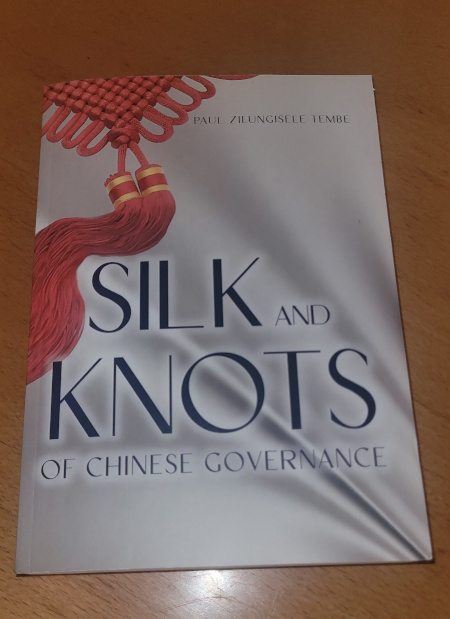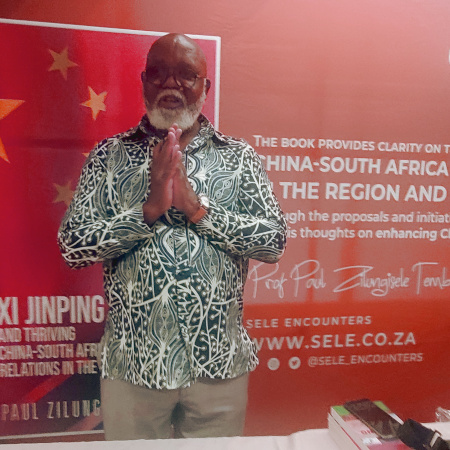Professor Paul Zilungisel Tembe's latest work Silk and the Knots of Chinese Governance is a rich and multifaceted exploration of the complex threads that weave together China's ancient past and its current model of governance. The title itself offers a metaphorical view of the complexity of Chinese civilization, evoking the idea of silk for its delicacy and knots for its structured discipline. This duality aptly frames the book's central themes: the performative language of governance, the legacy of dynasties, and the essential interplay of indigenous knowledge systems in shaping the nation's progress.
Prof. Tembe, a renowned sinologist, uses an autoethnographic approach to capitalize on his academic rigor and personal insight. Drawing on his qualitative research and deep engagement with Chinese culture and governance, he creates a narrative that not only explores China's unique trajectory but also highlights parallels with African civilizations. These comparisons broaden the scope of the book and make it an essential work for readers interested in cross-cultural governance and social cohesion.
Jingshen, Chengyu and Laosanspian
The core of the book Silk and the Knots of Chinese Governance is a deep dive into the performative linguistic structures of Mandarin, particularly through the lens of chengyu, four-character idioms that hold profound wisdom and historical lessons. Tembe reveals how these idioms, which are steeped in ancient Chinese philosophy, have shaped cultural identity and the framework of governance in modern China.
An instructive example of this cultural continuity is Laosanspian, or "The Three Constantly Read Articles". These short essays, written by Mao Zedong before the founding of the People's Republic of China (PRC) in 1949, are imbued with the jingshen (spirit) of the Chinese nation. They include:
1. Serve the people - emphasize selfless devotion to the public good.
2. In memory of Norman Bethune - a tribute to internationalism and commitment to humanitarian values.
3. The Crazy Old Man Who Moved Mountains - an allegory of perseverance and collective effort.
Laosanspian, presented in a concise and evocative chengyu, is an example of how millennia of Chinese civilisation influences modern governance. These texts are an integral part of the Chinese education system and instill the values of discipline, perseverance and innovation, qualities that have fueled China's global rise.


Chinese governance: the communitarian model
Tembe provides a compelling analysis of how the Chinese model of governance seamlessly integrates dynastic heritage with modern socialist principles. He challenges the oft-cited notion that China's success is purely economic, arguing instead that its achievements stem from a deeply rooted communitarian ethos. This ethos favours social cohesion and functional systems over individualistic endeavours.
Drawing on parallels with African civilizations, Tembe highlights how indigenous knowledge systems have historically promoted harmony and prosperity in both regions. In this context, he criticizes the Western emphasis on individualism, which he argues has led to social fragmentation and political chaos. In contrast, the Chinese governance model, which respects collective traditions while encouraging innovation, offers an alternative paradigm that could resonate with African nations seeking to reconcile their development with indigenous values.
Africa and China, a mutual learning process
One of the most interesting aspects of the book is the exploration of the possibilities for mutual learning between Africa and China. Tembe argues that Africa's indigenous knowledge systems, like China's, can be crucial in shaping its development trajectory. He draws parallels between the African philosophy of Ubuntu, which emphasises interconnectedness, and the Chinese emphasis on collective well-being.
In discussing the incorporation of African indigenous knowledge into the school curriculum, Tembe envisions a future in which education becomes more attuned to cultural realities and encourages innovation through the dynamics of culture and tradition. He sees this as a path to a "familiar environment" that empowers African societies, much as the Chinese education system has used its historical heritage to make remarkable progress.
Performative language as a management tool
The key contribution of the book Silk and the Knots of Chinese Governance is an analysis of Mandarin as a performative language that goes beyond mere communication and becomes an instrument of governance. Tembe explains how the structure and symbolism of the Chinese language reflects the collective psyche of the nation. Mandarin, with its emphasis on context and relational meaning, reflects the interdependence and continuity inherent in Chinese governance.
This linguistic perspective illuminates China's ability to maintain stability and cohesion despite rapid modernisation. Tembe suggests that African nations with a rich diversity of indigenous languages can take inspiration from this approach. By revitalizing and incorporating these languages into governance and education, Africa can engender a deeper sense of identity and resilience.
Global Implications and Civilization Initiative
Prof. Tembe considers China's rise not only an economic but also a civilizational phenomenon. He links his narrative to President Xi Jinping's Global Civilisation Initiative, which promotes mutual learning and dialogue between cultures. In this context, Tembe sees China as a country willing to take responsibility for leading the world towards a more inclusive and dynamic global paradigm.
This vision challenges the Western-dominated narrative of development and governance and offers a model rooted in cultural authenticity and adaptability. For African nations, this rapprochement with China presents an opportunity to forge a path that is both modern and deeply rooted in the dynamics of heritage.
Book Silk and the Knots of Chinese Governance is a masterful exploration of the threads that connect history, culture and governance. Professor Tembe's interdisciplinary approach provides a nuanced understanding of China's rise and its significance for Africa and the wider world. By engaging with performative language, indigenous knowledge and historical continuity, the book offers a blueprint for sustainable development based on cultural authenticity.
As China emerges as a global leader, Tembe's work encourages readers to reflect on the values and systems that support real progress. For African nations, the parallels presented in this book offer a blueprint for using indigenous knowledge to create workable and transformative models of governance.
In a world increasingly defined by cultural exchange, Silk and the Knots of Chinese Governance is a timely reminder of the enduring power of ancient wisdom in shaping modern reality.
Kirtan Bhana Book Review
PHOTO - TDS
TDS/ gnews - RoZ



